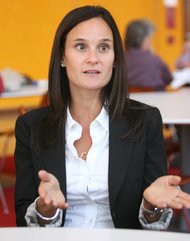She Owns It
Portraits of women entrepreneurs.
 Earl Wilson/The New York Times Alexandra Mayzler: The company is growing — but slowly.
Earl Wilson/The New York Times Alexandra Mayzler: The company is growing — but slowly.
At the most recent meeting of the She Owns It business group, we talked about the challenges of growing a business.
Alexandra Mayzler, who owns Thinking Caps Group, said her growth concerns are different than they were three years ago. Back then, she said she feared growth because she wasn’t sure she could find the right infrastructure and employees. Now, she said, she feels confident about the company’s infrastructure. The Thinking Caps playbook, which she recently updated, covers everything from how to draft an e-mail to the principles that underlie what the company does.
She said she believes that, with the resources she’s created, she can now communicate her vision to new employees. “I’m not saying I’m perfect and I don’t have a lot to learn,” she said, “but there’s enough infrastructure and training and leadership in place that you should be able to succeed unless it’s just not a good fit.” Now, she said, she needs to work on making the right long-term hires — and putting more focus on growth.
In the last few years, Thinking Caps has branched into Princeton, N.J., and Texas, with locations in Austin, Dallas, and Houston. It has also added a service called Prepare for Launch, a program for college students. “The company has been growing every year, but not a significant amount,” Ms. Mayzler said. The growth she has achieved, she said, has been primarily organic.
“At a certain point that sort of slows to a crawl, and then you need to put both oars in the water,” said Beth Shaw, who owns YogaFit.
“That’s exactly where I am,” Ms. Mayzler said. “In the beginning, you have to go out there pounding the pavement, and then it got to a place where we got our sort of low-hanging fruit.” The company is still growing — but slowly. Ms. Mayzler acknowledged she hadn’t made a concerted effort: “The conversation that I had with myself yesterday was, Is that good enough?”
“If you’re a true entrepreneur, it’s rarely good enough,” Ms. Shaw said.
Ms. Mayzler agreed. She conceded that she thought briefly about taking it easy. “I was like, Oh, this is fun, I can just take the summer off, this will be great,” she said. But when she woke up the next day, she said she realized she wanted to see the company “grow to the next level.”
And she said she thinks she finally knows what needs to be done. Much of her uncertainty, she said, was the result of her lack of infrastructure and her struggles to hire the right employees. “Maybe I have to deal with the fact that that perfect person doesn’t exist,” she said. She added that she had also realized that she may have to get better at making her expectations known to her staff and then following through when they fail to live up to them.
Looking back on the last two years, she said she now realizes she vacillated between micromanaging and stepping back too much. “I need to be consistent,” she said. “And I need to not be afraid of telling people what I think should be done. And when I’m evaluating things and when I think they’re not going well, I need to not be like, ‘Okay, let’s hope for the best next month.’”
With the infrastructure in place and some management lessons learned, Ms. Mayzler said she plans to “go after the middle-hanging fruit” in a strategic way. “We need to stop resting on our laurels and we need to get out there, and get out there in an organized way,” she said. In considering each location, she said she realized she had merely “gone through the motions” of expanding the business in New York. She added that she now sees she wasn’t truly committed to the idea because she was letting management issues distract her.
“I can say to myself, Oh, we didn’t get major results this year, but I tried,” she said of her efforts in New York. “But if I’m honest with myself, I don’t really think I really tried.” So, while she continued to work 12-hour days and cross items off her to-do list — for example, by sending a certain number of e-mails seeking partnerships with organizations like the Y.M.C.A. or the Jewish Community Center — her heart wasn’t in it.
But this summer, she is making plans. “I’m going to start September actually having very concrete goals because this year I was very flexible with myself,” she said. “I can’t wait for the school year to begin so we can actually do it.”
“That’s a big shift for you, because you haven’t been sure for a very long time,” Ms. Shaw said.
You can follow Adriana Gardella on Twitter.
Article source: http://boss.blogs.nytimes.com/2013/07/08/growing-your-business-how-do-you-define-good-enough/?partner=rss&emc=rss




